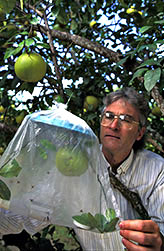Natural Product Outdoes Malathion
 Entomologist Michael Hennessey checks a field cage surrounding white grapefruit for effects of a bait formulation on Caribbean fruit flies. (K7029-1) |
It's true. You really can draw more flies with honey—or, at least, with sugar—and kill them, too, according to two scientists in the ARS Subtropical Horticulture Research Laboratory in Miami, Florida.
These scientists are lacing their sugar with abamectin—a natural ingredient produced by a common soil microorganism—to make a bait that knocks out the Caribbean fruit fly. Produced by the fungus Streptomyces avermitilis, this biological bait additive could be a possible alternative to malathion, the insecticide growers are now using.
Entomologist Michael K. Hennessey and chemist Jimmie R. King have been testing the new bait—made with sugar, a little yeast, and abamectin—for more than a year.
"Fresh citrus being shipped to consumers in Japan, Thailand, California, Texas, Bermuda, and Hawaii must be certified free of the Caribbean fruit fly," Hennessey says. The citrus industry relies heavily on pest-free certification for exporting.
"One option for meeting this certification requirement to ensure fly-free fruit requires aerial application of a malathion bait spray to groves every 7 to 10 days during harvest," he says.
The spray contains 190,000 parts per million malathion, to ensure that no fruit flies survive. Currently, there is no suitable substitute for malathion.
The alternative to certification is fumigation of fruit with methyl bromide, but that chemical is being phased out in 2001.
"This past season about 186,000 acres of Florida citrus were certified fly-free, including 66,000 acres that qualified by hail spray applications," reports Richard Gaskalla, who is with Florida's Department of Agriculture and Consumer Services. "Growers may make from one to several applications of malathion bait spray during the reason."
Gaskalla says the citrus industry and regulatory officials would welcome a natural alternative.
Presently, under Florida's Caribbean Fruit Ply Pest Management System, a grower may qualify for fruit certification either by negative trapping (putting out fly traps and not catching any flies) or by combining the trapping with aerial bait spray applications.
But Californians have voiced health concerns about malathion. And some studies have shown that adult female Mediterranean fruit flies are becoming tolerant to it.
Because of this noted medfly resistance, Hennessey thinks that "it is just a matter of time before the caribfly develops a tolerance also."
In lab tests, the abamectin bait was 100 percent effective at 50 parts per million, which is only 0.03 percent of the amount of malathion needed to do the same job.
It took a stronger dose of abamectin to kill the males, Hennessey says. "That's probably because the female is more interested in food than the male is. In this species, the male is trying to attract the female, so food is secondary; to the female, it's a primary concern. But both male and female flies are problems for growers.
Because abamectin is a natural product, King says it would be an ideal pest control. The compound paralyzes the fly's nervous system, leading to death. Another form of it is already registered for use on Florida citrus to control the citrus rust mite, Phyllocoptruta oleivora.
"Abamectin is effective at low concentrations and degrades rapidly,” King adds, '"The bait interrupts the pest's life cycle. By eliminating females, we also eliminate eggs."
Hennessey and King are applying for a patent for use of the bait again the caribfly and are looking for companies interested in a Cooperative Research and Development Agreement to commercialize the product. The bait can be applied with the same equipment now used to apply malathion.
"We plan to use our new abamectin bait on the medfly next, probably on an experimental research grove in Central America," Hennessey says. — By Doris Stanley, ARS.
USDA-ARS Subtropical Horticulture Research Laboratory, Miami, FL
"Natural Product Outdoes Malathion" was published in the January 1996 issue of Agricultural Research magazine.






